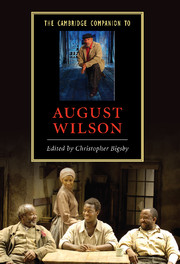Book contents
- Frontmatter
- 1 August Wilson: the ground on which he stood
- 2 Been here and gone
- 3 August Wilson’s relationship to black theatre: community, aesthetics, history and race
- 4 Music and mythology in August Wilson’s plays
- 5 Gem of the Ocean and the redemptive power of history
- 6 Joe Turner’s Come and Gone
- 7 Ma Rainey’s Black Bottom: cutting the historical record, dramatizing a blues CD
- 8 A piano and its history: family and transcending family
- 9 The tragedy of Seven Guitars
- 10 Safe at home?: August Wilson’s Fences
- 11 Two Trains Running: blood on the tracks
- 12 Jitney, folklore and responsibility
- 13 King Hedley II: in the midst of all this death
- 14 Radio Golf: the courage of his convictions - survival, success and spirituality
- 15 Critics on August Wilson
- 16 An interview with August Wilson
- Index
7 - Ma Rainey’s Black Bottom: cutting the historical record, dramatizing a blues CD
Published online by Cambridge University Press: 28 January 2008
- Frontmatter
- 1 August Wilson: the ground on which he stood
- 2 Been here and gone
- 3 August Wilson’s relationship to black theatre: community, aesthetics, history and race
- 4 Music and mythology in August Wilson’s plays
- 5 Gem of the Ocean and the redemptive power of history
- 6 Joe Turner’s Come and Gone
- 7 Ma Rainey’s Black Bottom: cutting the historical record, dramatizing a blues CD
- 8 A piano and its history: family and transcending family
- 9 The tragedy of Seven Guitars
- 10 Safe at home?: August Wilson’s Fences
- 11 Two Trains Running: blood on the tracks
- 12 Jitney, folklore and responsibility
- 13 King Hedley II: in the midst of all this death
- 14 Radio Golf: the courage of his convictions - survival, success and spirituality
- 15 Critics on August Wilson
- 16 An interview with August Wilson
- Index
Summary
Ma Rainey's Black Bottom (1984), Kim Pereira points out,
resembles a jazz composition . . . [each musician's story at the outset] is like a solo performance in a jazz quartet that, though it possesses the characteristics of a 'set piece', is related to the major themes on an imagistic and emotional level . . . As the play moves along easily, its improvisatory cadences contain ever-quickening impulses that gather force toward a cataclysmic ending, like a shattering crescendo.
Pereira's description, however, applies not only to Ma Rainey but, more generally, to Wilson's approach to drama. As I have written elsewhere, because his plays resemble
a jazz set as much as they do a Euro-American play, we are confronted not with protagonist and antagonists, but rather with the tension of interpretive energy, as a community of players play off one another's solos. If they tend at times to play variations on recognizable themes, the synergy of the interaction creates unexpected and exciting results rather as in a piece by Duke Ellington or John Coltrane.
Nor is it only a matter of style. Wilson's use of the blues instantiates an alternative form of historiography so that a blues rendition can have the same status for African American culture as a history text. 'The thing about the blues', Wilson has said, 'is that there's an entire philosophical system at work. And whatever you want to know about the black experience in America is contained in the blues.' If Wilson's drama is fundamentally structured by blues performance, his ten-play cycle can be thought of as a record (or CD) album that orchestrates and arranges the American twentieth century as ten versions of African American blues, played by a combo with one to three singers.
- Type
- Chapter
- Information
- The Cambridge Companion to August Wilson , pp. 102 - 112Publisher: Cambridge University PressPrint publication year: 2007



